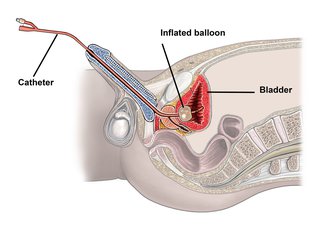Different types of urinary catheter are used in different ways.
Intermittent urinary catheters
Intermittent urinary catheters are the most common type.
These are inserted several times a day, for long enough (usually a few minutes) to drain your bladder. They are then removed.
You will be shown how to insert the catheter. It's usually inserted into your bladder through the urethra. This is the tube that carries pee out of your body.
The catheter is usually pre-lubricated. This reduces the risk of any discomfort when you insert it.
One end is either left open-ended to allow drainage into a toilet or attached to a bag to collect your pee. You guide the other end through your urethra until it enters your bladder and pee starts to flow.
When the flow of pee stops, you can remove the catheter. You use a new catheter each time.
Indwelling urinary catheters
An indwelling catheter is inserted in the same way as an intermittent catheter. But the catheter stays in place.
The catheter is held in your bladder by a water-filled balloon. This stops it falling out. These types of catheters are often known as Foley catheters.

Your pee drains through a tube connected to a collection bag. You can strap this to the inside of your leg or attach it to a stand on the floor.
Indwelling catheters are sometimes fitted with a valve. You can open the valve and drain your pee into a toilet. You can close it to let your bladder fill with pee until you can go to a toilet.
You will need to change an indwelling catheter at least every 3 months.
Suprapubic catheters
A suprapubic catheter is a type of catheter that stays in place.
The catheter is inserted through a hole in your abdomen and then into your bladder.
This can be done under:
- general anaesthetic
- epidural anaesthetic
- local anaesthetic
You can use a suprapubic catheter if your urethra is damaged or blocked. You can also use one if you are not able to use an intermittent catheter.
You can secure the catheter to the side of your body and attach it to a collection bag strapped to your leg.
Also, a valve that opens to allow you to drain pee into a toilet can be attached. It closes to allow your bladder to fill with pee until you need to go to the toilet.
This type of catheter is usually changed every 6 to 8 weeks.
Read more about living with a urinary catheter
Content supplied by the NHS and adapted for Ireland by the HSE
